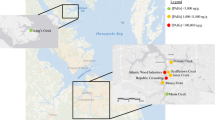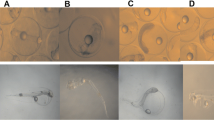Abstract
After pregnant mummichog were implanted with 1-nitronaphthalene or 1-nitropyrene via cholesterol pellet, we investigated the effects of the chemicals on embryo normality, hatchability and days to hatch of normal embryos, and growth and survival of hatched larvae from normal embryos of the implanted mummichog. Hatchability was the parameter most sensitive to the effects of both 1-nitronaphthalene and 1-nitropyrene. The 4-week lowest-observed-effect concentration (LOEC) of 1-nitronaphthalene, based on the actual concentrations in the eggs in the test, was 447 ng g−1 wet wt.; and the LOEC and no-observed-effect concentration (NOEC) of 1-nitropyrene were 958 and 344 ng g−1 wet wt., respectively. The 4-week LOEC of 1-nitronaphthalene, based on the concentration in the water, was estimated at 4.8 µg L−1 by using the reported bioconcentration factor; and the LOEC and NOEC of 1-nitropyrene, based on the concentration in the water, were estimated at 3.1 and 8.6 µg L−1, respectively. The reported environmental concentrations of 1-nitropyrene and 1-nitronaphthalene are over three magnitudes lower than the toxicity values we obtained. Therefore, the effects of environmental levels of 1-nitropyrene and 1-nitronaphthalene on fish reproduction, not including genomic effects on embryos, appear to be almost negligible. However, DNA damage has been detected in marine organisms exposed to 1-nitropyrene. Further studies of the genotoxicity of nitrated polycyclic aromatic hydrocarbons at environmental levels are therefore needed to evaluate their ecotoxicological risks.


Similar content being viewed by others
References
Armstrong PB, Child JS (1965) Stages in the normal development of Fundulus heteroclitus. Biol Bull 128:143–168
Atkinson R, Arey J (1994) Atmospheric chemistry of gas-phase polycyclic hydrocarbons: formation of atmospheric mutagens. Environ Health Perspect 102:117–126
Bacolod ET, Uno S, Tanaka H, Miki S, Kokushi E, Fukunaga M, Koyama J (2013a) Bioconcentration of waterborne nitroarenes in marbled flounder Pleuronectes yokohamae. Jpn J Environ Toxicol 16:91–105
Bacolod ET, Uno S, Tanaka H, Koyama J (2013b) Micronuclei and other nuclear abnormalities induced in erythrocytes of marbled flounder, Pleuronectes yokohamae, exposed to dietary nitrated polycyclic aromatic hydrocarbons. Jpn J Environ Toxicol 16:79–89
Barmford HA, Baker JE (2003) Nitro-polycyclic aromatic hydrocarbon concentrations and sources in urban and sub-urban atmospheres of Mid-Atlantic region. Atmos Environ 37:2077–2091
Busby WF Jr, Stevens EK, Kellenbach ER, Cornelisse J, Lugtenburg J (1988) Dose-response relationships of the tumorigenicity of cyclopenta[c, d]pyrene, benzo[a]pyrene and 6-nitrochrysene in a newborn mouse lung adenoma bioassay. Carcinogenesis 9:741–746
Crim LW, Sherwood NM, Wilson CE (1988) Sustained hormone release. II. Effectiveness of LHRH analog (LHRHa) administration by either single time injection or cholesterol pellet implantation on plasma gonadotropin levels in a bioassay model fish, the juvenile rainbow trout. Aquaculture 74:87–95
Curtis MW, Ward CH (1981) Aquatic toxicity of forty industrial chemicals: testing in support of hazardous substance spill prevention regulation. J Hydrology 51:359–367
Edmunds JS, McCarthy RA, Ramsdell JS (2000) Permanent and functional male-to-female sex reversal in d-rR strain medaka (Oryzias latipes) following egg microinjection of o, p’-DDT. Environ Health Perspect 108:219–224
Ishaq R, Akerman G, Naf C, Balk L, Bandh C, Broman D (1999) Organic pollutant characterization and toxicity testing of settling particulate matter by nanoinjection in sea trout (Salmo trutta) eggs. Environ Toxicol Chem 18:533–543
Kawanaka Y, Sakamoto K, Wang N, Yun SJ (2007) Simple and sensitive method for determination of nitrated polycyclic aromatic hydrocarbons in diesel exhaust particles by gas chromatography-negative ion chemical ionisation tandem mass spectrometry. J Chromatogr 1163:312–317
Manzetti S (2012) Ecotoxicity of polycyclic aromatic hydrocarbons, aromatic amines, and nitroarenes through molecular properties. Environ Chem Lett 10:349–361
Mitchelmore CL, Chipman JK (1998) Detection of DNA strand breaks in brown trout (Salmo trutta) hepatocytes and blood cells using the single cell gel electrophoresis (comet) assay. Aquat Toxicol 41:161–182
Mitchelmore CL, Birmelin C, Livingstone DR, Chipman JK (1998) Detection of DNA strand breaks in isolated mussel (Mytilus edulis L.) digestive gland cells using the “comet” assay. Ecotoxicol Environ Saf 41:51–58
Murahashi T, Ito M, Kizu R, Hayakawa K (2001) Determination of nitroarenes in precipitation collected in Kanazawa, Japan. Water Res 35:3367–3372
Nielsen T (1984) Reactivity of polycyclic aromatic hydrocarbons towards nitrating species. Environ Sci Technol 18:157–163
Ohe T, Nukaya H (1996) Genotoxic activity of 1-nitropyrene in water from the Yodo River. Jpn Sci Total Environ 181:7–12
Onduka T, Ojima D, Kakuno A, Mochida K, Ito K, Koyama J, Fujii K (2012) Nitrated polycyclic aromatic hydrocarbons in the marine environment: acute toxicities for organisms at three trophic levels. Jpn J Environ Toxicol 15:1–10
Ozaki N, Takemoto N, Kindaichi T (2010) Nitro-PAHs and PAHs in atmospheric particulate matters and sea sediments in Hiroshima Bay Area, Japan. Water Air Soil Pollut 207:263–271
Papoulias DM, Noltie DB, Tillitt DE (2000) An in vivo model fish system to test chemical effects on sexual differentiation and development: exposure to ethinyl estradiol. Aquat Toxicol 48:37–50
Schults TW, Moulton BA (1985) Structure-activity relationships for nitrogen-containing aromatic molecules. Environ Toxicol Chem 4:353–359
Shimada T, Murayama N, Yamazaki H, Tanaka K, Takenaka S, Komori M, Kim D, Guengerich FP (2013) Metabolic activation of polycyclic aromatic hydrocarbons and aryl and heterocyclic amines by human cytochromes P450 2A13 and 2A6. Chem Res Toxicol 26:529–537
Shimizu A (1997) Reproductive cycles in a reared strain of the mummichog, a daily spawner. J Fish Biol 51:724–737
Uno S, Tanaka H, Miki S, Kokushi E, Ito K, Yamamoto M, Koyama J (2011) Bioaccumulation of nitroarenes in bivalves at Osaka Bay, Japan. Mar Pollut Bull 63:477–481
Wislocki PG, Bagan ES, Lu AYH, Dooley KL, Fu PP, Han-Hsu H, Beland FA, Kadlubar FF (1986) Tumorigenicity of nitrated derivatives of pyrene, benzo[a]anthracene, chrysene and benzo[a]pyrene in the newborn mouse assay. Carcinogenesis 7:1317–1322
Yaffe D, Cohen Y, Arey J, Grosovsky AJ (2001) Multimedia analysis of PAHs and nitro-PAH daughter products in the Los Angeles Basin. Risk Anal 21:275–294
Yamazaki H, Hatanaka N, Kizu R, Hayakawa K, Shimada N, Guengerich FP, Nakajima M, Yokoi T (2000) Bioactivation of diesel exhaust particle extracts and their major nitrated polycyclic aromatic hydrocarbon components, 1-nitropyrene and dinitropyrenes, by human cytochromes P450 1A1, 1A2, and 1B1. Mut Res 472:129–138
Acknowledgments
We are grateful to Ms. Miki Shoda and Ms. Chiaki Hiramoto (National Research Institute of Fisheries and Environment of the Inland Sea) for their kind help. This study was supported by the development fund “Research on dynamics of nitroarenes in inner bay regions and influence on marine organisms,” from the Ministry of the Environment, Japan.
Conflict of interest
The authors declare that they have no conflict of interest.
Author information
Authors and Affiliations
Corresponding author
Rights and permissions
About this article
Cite this article
Onduka, T., Ojima, D., Ito, K. et al. Reproductive toxicity of 1-nitronaphthalene and 1-nitropyrene exposure in the mummichog, Fundulus heteroclitus . Ecotoxicology 24, 648–656 (2015). https://doi.org/10.1007/s10646-014-1412-6
Accepted:
Published:
Issue Date:
DOI: https://doi.org/10.1007/s10646-014-1412-6




